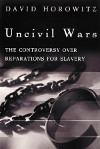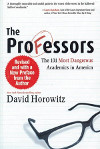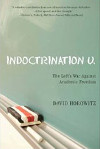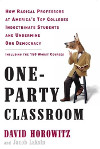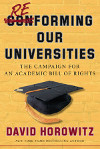One Party Classroom Introduction
An Academic Tragedy*
To appreciate the radical changes that have taken place in America’s universities over the past few decades, one could do worse than start with the University of California, Santa Cruz.
Academic courses at Santa Cruz and other California campuses are ostensibly governed by the “Standing Orders” of the university Regents. These state that each school must “remain aloof from politics and never function as an instrument for the advance of partisan interests,” and that professors must never allow the classroom “to be used for political indoctrination.” In the words of the Regents, such indoctrination “constitutes misuse of the University as an institution.”1
Unfortunately, this rule and rules like it at academic institutions across the country are increasingly ignored by university professors, and almost never enforced by university administrations. The UC Santa Cruz catalog is itself littered with course descriptions that promise indoctrination, almost invariably in radical politics. The clear goal of such courses is not to educate students in the methods of critical thinking but to instill ideologies that are hostile to American society and its values. Contrary to the Standing Orders of the university Regents, these courses teach students what to think, not how to think.
The Santa Cruz catalog, for example, describes a seminar offered by its “Community Studies Department” as follows: “The goal of this seminar is to learn how to organize a revolution. We will learn what communities past and present have done and are doing to resist, challenge, and overcome systems of power including (but not limited to) global capitalism, state oppression, and racism.”2
This is the outline of a political agenda, not the description of a scholarly inquiry. Moreover, the sectarian character of this course reflects far more than the misguided pedagogy of an aberrant instructor. University faculty are credentialed, hired, and promoted by committees composed of faculty peers.
To create an academic course requires the approval of the tenured leaders of an academic department who have been hired and then promoted by other senior faculty. For a department to survive and flourish, its curriculum must be recognized and approved by professional associations that are national in scope. Consequently, the fact that a course in how to organize a revolution is offered at one of the nation’s distinguished academic institutions speaks volumes about the contemporary university and what it has come to regard as an appropriate academic course of study.
The Community Studies Department at UC Santa Cruz is by no means alone in its departures from scholarly principle. The school also boasts a “Department of the History of Consciousness,” which was created in the 1960s as a platform for political radicals. Communist Party stalwart Angela Davis—a onetime federal fugitive featured on the FBI’s Ten Most Wanted list—has been a faculty icon for decades.3 Black Panther felon Huey Newton received a Ph.D. from the department by submitting a dissertation that was little more than a political tract justifying his organization’s criminal activities. Another prominent radical credentialed in the program and then hired to its faculty is Bettina Aptheker, creator of UCSC’s Department of Feminist Studies.
The daughter of a famous leader of the Communist Party, Professor Aptheker was herself on the party’s central committee for many years. Aptheker finally left the party in 1981 after her superiors rejected a political tract she had submitted for publication to the party publishing house. Her manuscript was considered unacceptable because it argued that women were oppressed due to their gender and not merely their class position.4 In a recent memoir, Aptheker explained that she agreed to pursue an academic career only after another professor and long-time Communist Party member told her, “It’s your revolutionary duty.”5
In pursuit of her revolutionary goals, Aptheker devoted herself to revamping the curriculum of the newly created “Introduction to Women’s Studies” course, “making it more overtly political” and turning it into a training program in radical feminism and an adjunct of the women’s movement.6 “Teaching became a form of political activism for me, replacing the years of dogged meetings and intrepid organizing with the immediacy of a liberatory practice.”7
Aptheker was appointed the first professor of Women’s Studies at Santa Cruz and went on to build an entire academic department based on her political agendas, shaping its course offerings for a quarter of a century. At her instigation, the department was eventually renamed the Department of Feminist Studies, which finally captured her achievement: the embedding of a political program in an academic curriculum, despite the explicit warning by the UC Regents that this “constitutes a misuse of the university.”
Bettina Aptheker’s academic career is a metaphor for the political trends that have reshaped America’s liberal arts classrooms over the past generation. A lifelong political activist, Aptheker regarded the university first and foremost as a fulcrum for revolutionary change. In furthering her political goals, she received extensive support from crucial elements of the university system. This support included, first of all, the academic department that awarded her a Ph.D. for non-scholarly work. Like Newton’s, her doctoral thesis was not a scholarly dissertation but the political tract she had previously submitted to the Communist Party publishing house. Once credentialed by the History of Consciousness program as a “scholar,” she was hired to the faculty and then promoted by committees dominated by other faculty radicals. These committees then approved the creation of a politically designed Women’s Studies program through which she could spread her doctrines. The central university administration then agreed to the expansion of the program into a full-fledged academic department and to its transformation into the Department of Feminist Studies.
Throughout the entire process, Aptheker’s ideological curriculum received the imprimatur of the National Women’s Studies Association (NWSA), which sets standards of discourse, research, and hiring in the field. Its support was entirely predictable, since the NWSA is itself a political organization whose formal constitution lays out its agendas in blunt fashion:
Women’s Studies owes its existence to the movement for the liberation of women; the feminist movement exists because women are oppressed. Women’s Studies, diverse as its components are, has at its best a shared a vision of a world free not only from sexism but also from racism, class-bias, ageism, heterosexual bias—from all the ideologies and institutions that have consciously or unconsciously oppressed and exploited some for the advantage of others. . . . Women’s Studies, then, is equipping women not only to enter the society as whole, as productive human beings, but to transform the world to one that will be free of all oppression.8
In sum, Professor Aptheker’s academic career and her politicized Department of Feminist Studies are made possible by a national movement of academics who share her broad ideological agendas. Over the course of several decades, this movement has instituted massive changes in the structure of higher education, creating new courses, new departments, and new fields that violate the professional standards of the modern research university and undermine its foundations.
These disturbing developments are the subject matter of One-Party Classroom. Recent decades have witnessed widespread complaints about the political abuse of university classrooms. But never before has anyone undertaken a comprehensive investigation of what America’s college instructors actually say they are teaching their students.
One-Party Classroom fills in those blanks. It documents the results of an in-depth, multiyear study of twelve representative schools— public and private, and ranging from large state universities to elite Ivy League institutions. Our investigation has systematically scrutinized course catalogs, syllabi, reading lists, professors’ biographies, scholarly records, and testimonies.
The outcome of our research leaves no doubt that the failure to enforce academic standards is a problem that is endemic to institutions of higher learning. An alarming number of university courses violate existing academic regulations that have been designed to ensure that students receive professional instruction. Curricula are designed not to educate students in critical thinking[1] but to instill doctrines that are “politically correct.” This is not a claim that professors are “biased.” Bias is another term for “point of view,” which every professor naturally possesses and has a right to express. For the purposes of this study, professors whose courses follow traditional academic standards do not pose a problem regardless of their individual point of view. What concerns us is whether their courses adhere to the academic standards of the modern research university and the principles of a professional education.9 And the fact is that a growing number of activist instructors routinely present their students with only one side of controversial issues in an effort to convert them to a sectarian perspective.
Once the widespread nature of the abuses is appreciated, it becomes impossible to argue that the problem is limited to a few aberrant instructors, or to offhand professorial comments, or to an occasional assignment of materials designed to sway students’ judgments on controversial matters.
The more than 150 college courses documented in these pages do not exhaust the political offerings at the twelve institutions studied; they are merely the most obvious cases at these schools. The ideologies presented in these courses often reflect prominent and even dominant schools of thought in their respective academic fields. More importantly, these ideological doctrines often shape the core curriculum most undergraduates are required to take to earn their degrees in liberal arts.
If we were to extrapolate from the materials examined here, taking into account the total number of institutions offering advanced degrees, the result would be as many as 10,000 college classes nationwide whose primary purpose is not to educate students but to train them in left-wing ideologies and political agendas. The students who pass through these courses annually are numbered in the millions. In other words, One-Party Classroom demonstrates beyond a reasonable doubt that the attempt to indoctrinate American college students is more pervasive and extreme than even the harshest critics of academia have previously suggested.
“No Tipping of the Scales”
Although the courses examined in this text reflect, without exception, a left-wing view of the world, the problems exposed would be just as serious if instructors were instilling conservative or right-wing doctrines. The reason for the absence of such courses in this study was our inability to locate them at the schools examined. This is not surprising. As recent surveys have shown, conservatives are an extraordinarily rare presence in contemporary liberal arts faculties. At several of the schools examined, we could not locate a single conservative professor on the social science faculty. A 2007 investigation by two liberal academics, Neil Gross and Solon Simmons, reported that liberal professors generally outnumber conservatives in the social sciences and humanities by a factor of 9 to 1.10 In fields such as anthropology and sociology, the ratio approaches 30 to 1, Consequently, in the mainstream university system, which is the focus of our inquiry, conservative professors lack the institutional means to create ideological departments or to design courses for the purpose of training students in right-wing doctrines.11
The roots of the present situation lie in the political history of the 1960s and its aftermath. The cultural upheavals of that era saw the accession to academic tenure of a generation of activists who regarded the university as a platform from which to advance their political mission. Drawing on the works of European Marxists such as Antonio Gramsci and Herbert Marcuse, and the educational theorist Paulo Freire, the radicals viewed universities as “means of cultural production” analogous to the “means of production” in Marx’s revolutionary schema. To these professorial activists, the academic classroom offered a potential fulcrum for revolutionary change. Because the university trained journalists and editors, lawyers and judges, future political candidates and operatives, it provided a path to cultural “hegemony” and an opportunity to promote a radical transformation of the society at large.
The efforts of this radical generation soon led to a dramatic shift in educational attitudes. When the modern research university was created a century ago, it signaled an end to the dominance of religious institutions in the field of higher education. Under the new dispensation, teachers were expected to refrain from imposing their religious or ideological prejudices on students in their charge, to teach according to the precepts of scientific method and not according to what the philosopher Charles Peirce referred to as the “method of authority.”
The most important and influential statement associated with this emergence of the modern research university was the “Declaration on the Principles of Academic Freedom and Academic Tenure,” a document issued by the American Association of University Professors (AAUP). The Declaration stipulated that a university instructor should “set forth justly, without suppression or innuendo, the divergent opinions of other investigators . . . and he should, above all, remember that his business is not to provide his srudents with ready-made conclusions, but to train them to think for themselves, and to provide them access to those materials which they need if they are to think intelligently.”12 This statement, issued in 1915, has provided the template for the academic freedom policies of most American universities ever since.
Equally explicit on these matters was a 1934 statement by Robert Gordon Sproul, the president of the University of California and the architect of its rise to academic prominence as an exemplar of the values to which a research university should aspire. In the 1934 statement, Sproul defined the mission of the university as incompatible with the agendas of sectarian political movements: “The function of the university is to seek and to transmit knowledge and to train students in the processes whereby truth is to be made known. To convert, or to make converts, is alien and hostile to this dispassionate duty. Where it becomes necessary in performing this function of a university, to consider political, social, or sectarian movements, they are dissected and examined, not taught, and the conclusion left, with no tipping of the scales, to the logic of the facts.”13
The Sproul statement was integral to the academic freedom policies of the University of California until 2003, when academic radicals succeeded in suppressing it. In that year, the academic senate voted to remove the Sproul statement from its academic freedom template by a majority of 43—3- This removal was engineered by Professor Robert Post, who is currently the principal authority on academic freedom for the AAUP.14
The activist mentality behind these moves was aggressively promoted in an article titled “Impassioned Teaching,” which was featured in the Summer 2007 issue of the AAUP’s official journal, Academe. It was timed to coincide with a new statement on academic freedom and was written by Pamela Caughie, a regional president of the AAUP and also a professor of English at Loyola University, Chicago, and its director of Women’s Studies.
“Don’t be afraid of classroom advocacy; it’s not the same as indoctrination,” Caughie advised other academics. But her text demonstrated that this was a distinction without a difference: “Feminism is a mode of analysis, a set of values, and a political movement. In teaching students its history, its forms, and its impact, I am teaching them to think and write as feminists. I want to convince my students of the value of feminist analysis and the importance of feminist praxis.” In other words, Caughie understands her educational mission as one of persuading students to adopt her point of view, not teaching them how to conduct an intellectual examination of feminism and think for themselves. Caughie is even ready to concede the point in a backhanded way: “In twenty years of teaching I have never gone into the classroom hoping to make converts that day. Still, I feel I am doing my job well when students become practitioners of feminist analysis and committed to feminist politics.”15
Caughie’s defense of the “praxis” of indoctrination in the official journal of the AAUP underscores the predicament in which American liberal arts programs find themselves. The radical cohort to which Caughie and Aptheker belong is now a large and influential presence and in some cases an imposing majority on liberal arts faculties and the governing bodies of national academic organizations. As a result, it has been able to transform significant parts of the academy into agencies of political and social change.
These include traditional professional groups such as the American Historical Association (AHA), which now routinely pass formal resolutions on public controversies that have nothing to do with scholarship, and which take positions on issues that only a handful of their thousands of members would be professionally qualified to judge. In 2007, for example, a tiny but determined minority of AHA members passed a resolution condemning the Iraq war. In doing so they exploited the scholarly prestige of AHA members gained in historical fields far removed from the Middle East in order to promulgate a fashionable left-wing position on current events.
The political subordination of scholarship to political agendas is most evident in fields such as Women’s Studies. Almost universally, Women’s Studies programs base their courses of study on the ideological (and unproven) claim that gender is “socially constructed”— that behavioral differences between men and women are socially, rather than biologically, determined. According to these Women’s Studies programs, gender differences between men and women are artificially created by an entrenched patriarchy for the express purpose of oppressing women. This perspective is presented by Women’s Studies faculties as a settled doctrine even though it is a controversial opinion. Recent advances in modern neuroscience, for example, have identified significant differences in the biological makeup of men and women that affect their relative abilities and behaviors.16 Yet for Women’s Studies faculties the issue is settled in favor of social determinants.
Ideological developments in the university have also led to the prevalent phenomenon of professors academically trained in one discipline teaching courses and posing as experts in others. Since radical ideologies require their adherents to make global pronouncements, it is not uncommon to find instructors with degrees in English or Comparative Literature teaching courses that focus on the historical development of economic empires or the complexities of gender and race. This is analogous to a situation where botanists and microbiologists would teach big bang physics or macroeconomics. It is a serious problem for academic professions, which are defined by their specialized knowledge. Entry into these professions is barred to individuals not credentialed as experts in their disciplines, while students pay tens of thousands of dollars for the privilege of being taught by specialists in their fields. Why go through the arduous and expensive process of credentialing experts if anyone is qualified to teach anything?
What we are witnessing in the liberal arts programs of American universities is the collapse of standards on an alarming scale. To describe this problem as one of “liberal bias” or a “lack of balance” is to misrepresent and trivialize it. All faculty, whatever their point of view, have intellectual biases and a right to express them. But the same right comes with an important and long recognized caveat: Professors have an obligation to be professional in their instruction. They are expected to refrain from imposing their personal views on students through the authority they exercise in the classroom, or through the design of the course, or through their power over student grades; they should not represent mere opinion as scientific fact.
The problem posed by the incorporation of ideological agendas into the academic curriculum is not the opinions of a particular instructor or a particular idea introduced in the course of instruction. The problem arises when the course of instruction is not guided by scientific method; when it is not constructed as a scholarly inquiry within a scholarly discipline; when the instructor fails to present students with divergent views on controversial matters or with access to materials that will enable them to think intelligently and for themselves. The problem facing the university today is that many academic courses are designed to train students in sectarian ideologies and recruit them to sectarian causes.
Even as the abuses of university classrooms documented in this study have reached epidemic proportions, faculty unions and professional associations have become increasingly averse to any accountability for the design of academic instruction. Roger Bowen, who until recently served as general secretary of the AAUP, has said in so many words that academics should not have to answer to anyone but themselves: “It should be evident that the sufficient condition for securing the academic freedom of our profession is the profession itself.”17
But the pages that follow show that left to their own devices, faculty and administrators have consistently failed to defend academic freedom or maintain reasonable academic standards. Routine abuses of the university are also made possible by the passivity of other actors— instructors in the hard sciences who observe traditional professional standards in their own work but choose to remain silent when these standards are traduced by others, non-ideological scholars in the liberal arts who do likewise, education-oriented trustees and alumni, and students abused by the practices described. These academic bystanders constitute a majority of any university community and a majority of faculty as well. But their refusal to speak up has allowed their less scrupulous colleagues to engineer a decline of professional standards, and a consequent debasement of the academic product.
If this passivity continues and the university community does not respond to the assault on academic standards, the credibility and authority of the university will continue to decline and the future of liberal arts education in America will then become bleak indeed.
